Global Health Rotation with Resource Exchange International in Vietnam – Dr. Angela Lai’s Blog
Written by Angela Lai, MD (a third year Pediatrics Resident from Kaiser Permanente, Oakland while on a global health elective in Saigon and Hanoi, Vietnam with Resource Exchange International.)
Day 1-2 (22 Feb – 23 Feb)
1500 local time – Tokyo Narita Airport
Last minute packing and finding trinkets and gifts for my Vietnamese friends is finally done. I haven’t thought much about the trip – haven’t really mentally prepared for what I might see or do. Partially, this is due to not really knowing – I’ve never really been on an “academic’ type mission trip before, usually its service based, setting up community clinics or traveling to various sites. There is something amazing about having the opportunity to see what others experience every day, to get a chance to look into the lives of others and get some perspective on how lucky I really am. On a side note, upon arrival at Tokyo Narita, I went to the restroom and totally forgot about the squatting toilets…welcome back to Asia!
00:18am Ho Chi Minh City (Saigon), Vietnam
Lien embraced me with a warm smile and hug and brought me straight through customs and immigration, then on to collect my things and into a taxi. We wove through Vespa traffic in the city towards the hotel, and I saw a girl in green high heels, casually riding side saddle on the back of a scooter…a braver woman than me! The cityscape and the traffic reminded me a little of china, people and scooters vying for road (and winning) against cars and taxis. No subways or trains here, some busses, most travel by motorbike or car. We are up early for breakfast and a 2 hospital tour/work day tomorrow, so its rest time for me. Can’t wait to see what it will bring!
Day 3 2300 local time -HCMC
What a day! Breakfast buffet in our hotel (pho & Vietnamese iced coffee- totally addicting), then off to children’s national #1 hospital. Dr. Lem and I spent the morning in the infectious disease ward, mostly in the 8 bed PICU. There a 15mo child with measles (unvaccinated) with its many complications (pneumonitis, encephalitis) was a mere 2 feet away from a child with Japanese encephalitis, an immune deficiency, a pneumococcal meningitis, hand foot and mouth disease (without rash), neiseria meningitis – our infection control people would have had a fit. When the children soiled themselves, parents were called in to clean them up. An RT gave albuterol via a non-rebreather, and nasal cpap was secured with some elastic ties behind the ears. A 9mo with sturge weber (+port wine stain) had a 20minute focal seizure until she was treated, then continued to seize intermittently. This is a whole other world. All the kids were fed thru NG’s or OG’s – no TPN. Patients and their families lined the hallways outside the ward on bamboo mats. They stay there with them and get brought into treatment rooms for procedures and meds. Dr. Dung, a quiet and confident 2nd year resident invited us to watch LP’s. We first saw a 14Y old male with hemolytic anemia, presumed 2/2 to hep B (ag positive, given highest prevalence – this was tested first). He was notably jaundiced. Next the first kid ~6-7yrs old was muscled down for an LP by the nurse/orderly and then Dr. Lem (no anesthesia, no local). LP’s were done with IV needs because they have no spinal needle – um..CSF leak anyone? And she whipped through 4 LP’s in quick succession. The first boy had weeks of headache and fever, the 2nd was a test of cure for presumed bacterial meningitis (glucose low, cell count indicative but no bacteria grown) – she had some nuchal rigidity. Crazy.
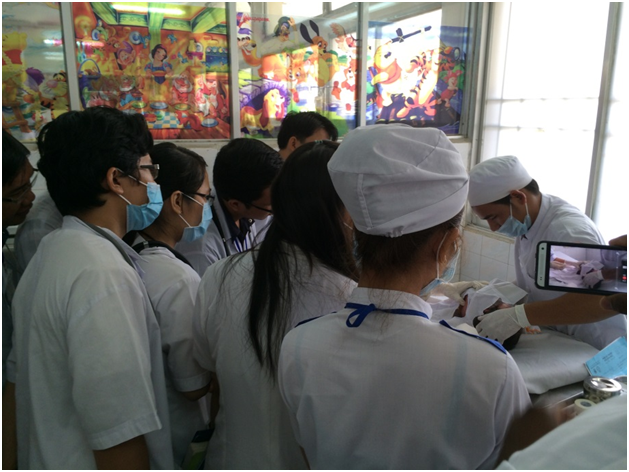
Next we explored the ward and gave out gifts – stickers, toys, pencils, etc and saw a room full of chicken pox! Blueberry muffin rashes galore. Lunch with Dr. Son, the director of the ENT department there, then off to the ENT hospital to give lectures. The translators struggled a little with our medical speak, but really did a fantastic job ( I think). Sharon got to see her post-op patient (he had a neck mass removal that was kind of dicey) – we initially couldn’t find him. 2 hours post op and he was running outside the ICU and getting food from the canteen with his father – that would never happen in the states. His eyes lit up when he got all the cool presents from Dr. Sharon.
Day 4 – Ho Chi Minh City
All of us were at Children’s hospital #1 today. We got to sit and have tea with the Dr. Hung – the Director of the hospital (and by trade a previous pedi ID doc). Dr. Son received some foreign body graspers from REI and Stortz brought over by Dr. Pine. This children’s hospital – the city hospital (one of two) sees about 1.8million children per year. They see ~300 newborns per day and 2500 cases of ROP per year. They have 6 pedi cardiothoracic surgeons and 2 retinal specialists to perform laser surgery. They do 3-400 cardiac surgeries per year and have 6 ICU’s – cardiac, surgical, NICU, PICU, burn. It’s a 1400 bed hospital and they admit ~5% of their outpatient volume per day (clinics can see up to 6000 patients per day – outpatient doctors average 1-2 minutes per visit).
Dr. Tuan – the director of the Pedi Hemorrhagic Dengue fever ward took us on a tour. We first went to the NICU, where I was shown around by one of the Neonatologists. She told us they resuscitate down to 27 weeks and do many surgeries. I saw a baby with gastroschisis – bowel in a bag lying on the side (not suspended like ours). The beds are small and there is no room for the mothers to come visit or stay. Thus, they don’t get any mom’s milk in the NICU, and their NEC rate is 15%. They do have a follow up clinic where they follow the children for 2 years in conjunction with neurology, but I wasn’t clear on services like nutrition, physical and occupational therapy – they do developmental testing, but I’m not sure how much support they get outpatient. Here we also saw conjoined twins – both on room air – joined at the chest. There are spinal anomalies and they share an anterior chest wall and pericardium, but have separate livers and hearts and lungs. They are planning on surgery tomorrow. There is a rising incidence of twin births here as well, due to IVF. It is interesting the dichotomy of what they are able to do, and the simple things that they are unable to do.
Dr. Tuan then took us to the dengue fever ward – his department. There is a very large number of cases of EBV, chronic and acute, and 1/3 of these kids have HLH – a pretty Uncommon disease in the states. He took us through the ward and showed us many patients, including one room where parents pay extra to have a private bed space – many people have to share. He rounded on these patients as well – although none of them actually had an ID issue – one had iron deficiency anemia vs thalassemia, one had chronic ITP. He has them on his ward because hematology is full. He also told us about his home clinic. Many doctors work of the government hospitals in order to have the opportunity to get support, higher positions, and access to further education. However, less than 1/3 of their salary is government, most have to have private clinic patients in order to supplement their income ($500 /mo from the government, 1000$ from the clinic). Their clinics are general – not specific to specialty so they see everything from dermatitis to kidney issues. I was also impressed by how quickly they change their plans in the hospital in order to move the kids through the system. One child was diagnosed with Pneumonia and started on 3 different antibiotics in 3 different days, was discharged home since he finally got better 1-2 days later. He made the comment – “he probably had a virus.” HA. The other impressive thing is how quickly they see their patients – 1-2minutes per patient (private clinics maybe 5-10mins per patient). There seems to be a fairly high compliance rate though and less need for explanation. And the parents expect things to go fast – they call and complain if the doctors are too slow!
Dinner was a Banh mi sandwich from a little cart in front of a camera store…AMAZING, then we walked to the “backpackers” area – a more expat /foreigner heavy area where people sit and drink on the sidewalk on little plastic chairs. It was crazy busy and amazing. We did café zoom first – where the group had done a Vespa tour a few days prior – then to this very busy street where we sat and ate street food and had a drink. The table next to us had a guy who did card tricks for us, lots of young people. We took a taxi back and had the most ridiculous driver – who commented and ranted about how foreign men were taking Vietnamese women (his girlfriend had dumped him for a white man….2 years ago…. And he was still VERY angry). He said, “How can I compete!” luckily we placated him with some kind words from Sharon…but it was hilarious. A crazy end to a crazy night.
Day 5 – Ho Chi Minh City to Hanoi
Lem and I were able to take the afternoon off as the ENT’s were whisked away to the ENT hospital for lectures. We all had lunch first on a rooftop overlooking the lake, then Lem and I walked around a bit in old town. He got so excited about being adventurous that we rented a motorbike!! First we went to Hoa Lo prison (after getting lost) – some crazy French prison stories from the days of the Vietnamese revolution. They also had a small room where they had mementos from WWII – this is where they held the American pilots that were shot down. They even had John McCain’s flight suit. There was a lot of interesting captions and propaganda.
We drove around the lake a few times on the motorbike, weaving in and out of traffic, then off towards the Ho Chi Minh mausoleum. We parked in a botanical garden then walked around to the square, past the presidential palace (no pictures allowed!) and to the mausoleum – we weren’t allowed, in, just outside. And there were special white uniformed policemen to wave us away. Motoring around the city on our way back to the hotel, was pretty amazing. We get to see how the locals travel and live a little! As we motored….breakdown! Our bike wouldn’t get out of first gear. A very friendly local man tried to help us, and after many attempts, pointed us in the direction of a “mechanic” (a man on the street in front of a store with a box of tools – how all mechanics in the city run, really, haha. After taking apart what seems like the every piece of the bike, he finally concluded it was a clogged air filter, cleaned it, and sent us on our way. Interesting realities here in Vietnam – most businesses are started by anyone with a mind for them, many run by women; and so many people are so friendly and just want to help those around them. I wonder if we would all be a little happier if the culture in the states was like this.
Day 6 – Hanoi – national children’s hospital
We visited the National Children’s Hospital in Hanoi today, first sitting down for tea with the director of the hospital, then a short tour with Dr. Lam through the infectious diseases ward and the hospital overall. The hospital had a very different feel in comparison to Children’s No 1 in HCMC, many more children (it IS the national hospital) but still much less crowded. It had more of a westernized hospital feel – colorful murals and paintings, hallways clear of families camping out, overhead pages and nursing stations much more reminiscent of what I’m used to seeing every day. Contrast that with 10 bed wards and a little surprise I received walking into the restroom shortly before lunch…..
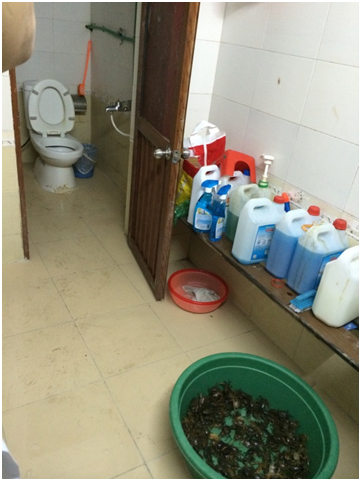
Both Dr. Lam and Dr. An were wonderful, and they were able to give me a short tour of their NICU as well. They resuscitate down to 26 weeks, have an active cardiac NICU, do many or most of the things that we do in our own hospital, with some notable exceptions. Parents have to pay for the use of inhaled Nitric Oxide (iNO), used to treat pulmonary hypertension – which is such a strange and incredibly weird concept to me. In a resource restricted country though, it really isn’t that completely out of the realm of normal I suppose. Infection rates are very high, as they don’t have the capacity to isolate their infected kids, as we do. Many of them end up on very broad spectrum antibiotics coming from the regional hospital, and they are unable to narrow, so they are breeding resistant organisms at a fast rate.
Later that day, we went exploring in the “old town” area of Hanoi – taking narrow side streets and walking around getting lost. Hanoi has a very different feel than Ho Chi Minh City, much more how I imagined Vietnam to look. There are many small shops in rows in old town, selling everything from handbags, scarves, and souvenirs to a whole street dedicated to kitchen appliances and building materials, including handmade furnaces and door handles on site, a regular home depot.
Day 7 & 8 – Ha Long Bay
Prior to our departure to Ha Long Bay, we took an early morning walk around the lake. There were an amazing number of people out and about, doing some morning exercise. There was a whole group of 30-40 women dance-exercising under and building’s overhang to get out of the rain, the music and instructors voice echoing across the lake from the speakers. On the other side of the lake, a handful of fit young guys had set up a temporary lake-side workout area, which we nicknamed Hanoi’s “muscle beach.”
After a 3 hour bus ride through the country and a short cruise, we reached the beautiful (but foggy) Ha Long bay. One of the 7 natural wonders of the world and home to these infamous ‘floating villages’.
Multiple families share usually a 1 or 2 room floating home, fish and live off the land and the water. Many of them are born here, live and work here, and then die here, without every touching the mainland. Even dogs live on these floating villages. There are even floating snack carts, women who row around with snacks and beverages on display on their small canoes, selling their wares to the passing tourism boats and workers.
The government is making an effort to move all of these floating villagers to the mainland – building apartments and schools in the nearby harbor town. They will be provided with better education for their children and more stability on land. The people can still fish in the bay and work, but they will no longer live there, putting an end to this unique and simple way of life.
Day 9 & 10– National ENT Hospital & University of Medicine Pham Ngoc Thach – HCMC
Flying back to Ho Chi Minh City, I met up with my second week team – an amazing group of ENT and Neurosurgeons from UNC Chapel Hill. We spent the first two days providing an update conference one of the national medical schools. Of note, their dean is female, consistent with the many successful women I have seen both in Medicine and business in this country. In fact, the two neurosurgeons on the trip – both of whom also happened to be female – were a huge surprise to their Vietnamese colleagues. It was interesting to observe their impressions of us and hear the questions of the various attendees from all over the city. It was an educational day both in the medical and cultural sense.
Day 11 – Gia Dinh City hospital
I got the opportunity to visit one of the smaller general hospitals in Ho Chi Minh City, Gia Dinh. This was set up by the wonderful connection one of the ENT doctors, Ha Tran, had with Dr. Senior. In fact, she had even visited UNC and had worked and studied under the ENT group there. Gia Dinh is a community general hospital, very similar to my own community hospital at home in Oakland. Among the many other specialties (ENT, dermatology, ER, OB/GYN) there is a15 bed pediatric ward with a small (i.e. one room 4-6 bed) nursery, and an outpatient pediatrics clinic. I spent most of my day visiting with and shadowing the head of the pediatrics department.
We had a very candid discussion about his department and its population. Gia Dinh is one of the smaller city general hospitals, so it is less well known than the larger children’s hospitals in the city (there are two). He wondered how he could best draw patients to his hospital, given that many people tend to just bring their children to the well known children’s hospitals. The advantage of a smaller place, though is in the individualized care each child receives, its structured and well established outpatient clinic program and vaccine clinic, and the ability for each family to actually have some space for their child as they are recovering. Granted, many of these may be my own biased perceptions of what this hospital has to offer over the larger, overcrowded city children’s hospitals, but there is a parody to this in our own healthcare system. Often, the value of individualized care and just plain familiarity with a particular patient and family is underestimated. Continuity of care with the same providers throughout a child’s life can make tough times and transitions much smoother.
Day 12 & 13 – Tourism in HCMC , Cu Chi Tunnels & Goodbye
I spent my last few days exploring Ho Chi Minh City and getting to know the culture and history of this beautiful country. We got the opportunity to spend a half day touring the city as it should be seen – on the back of a Vespa! The intersection of western and Asian cultures with a nod to their heritage and past is much more prevalent outside district 1, where all the high end shops and hotels are. We saw district 5 – the heart of china town and its transplanted Chinese-Vietnamese population of several million. Of particular interest was the War Remnants museum – full of pictures and displays of the “American War” and its lasting effects on the countryside, the people, and the history of Vietnam. There was also an interesting exhibit on the effects of Agent Orange, and all of its known (and presumed) effects on the people exposed and the generation of children born afterwards.
The Cu Chi Tunnels were a bit of a trek outside the city. This is a network of caves and underground dwellings dug out of the stone and rock in the Cu Chi countryside by the local villagers and farmers there. Initially used during the French occupation, they became more extensive during the “American War” as bombings and Agent Orange became more prevalent. Let’s just say that the propaganda and ‘historical’ video showed an interesting perspective on the war. The tunnels, though, were very small – definitely made for the smaller build Vietnamese people, and not for a bunch of tall Americans! It was hot and sticky and many tunnels required us to squat, waddle or scoot through. Oh, and there were bats! Amazing how people lived in these tunnels for years.
Overall, my trip to the beautiful country of Vietnam was a success. I was able to meet and visit many different areas of the country and its medical system. But more importantly, were the conversations I had with the people. These people are essentially doing the same jobs we are doing here every day – taking care of children. And yet, their day to day life, the volume of patients, the need for private outpatient clinics is very different. I’ve also found that there are many paradoxes – high end shopping and designer stores next to women selling fake watches and handbags on the street, restricted antibiotic use and lack of space and resources but complex and intricate surgery in the next room, new surgical techniques and high tech scopes but reusable drill bits and open toed sandals in the OR. All in all, an eye opening experience to another country, its culture and its people.
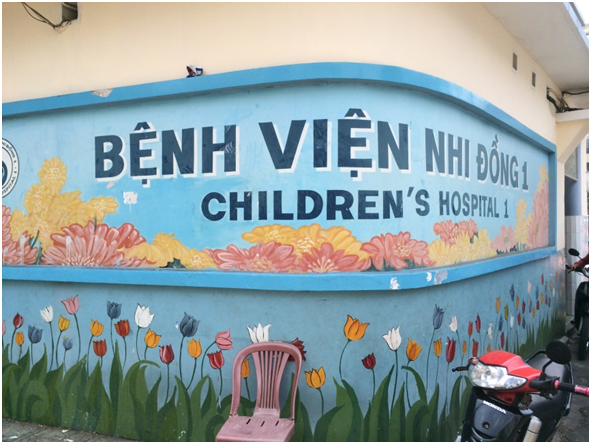
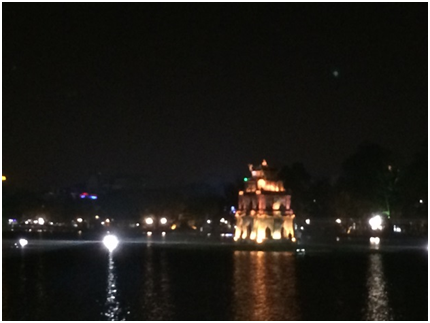
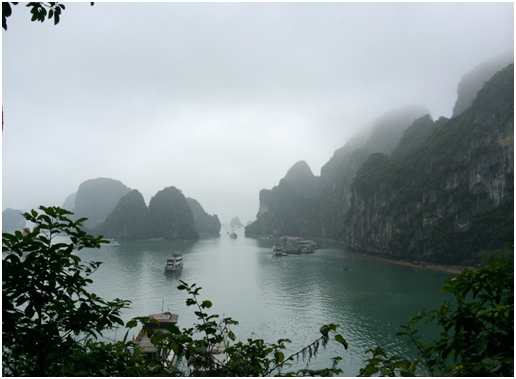
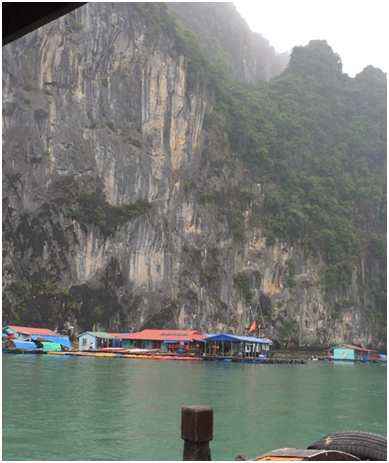
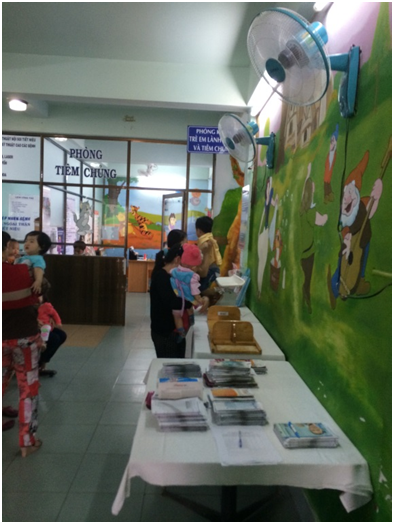
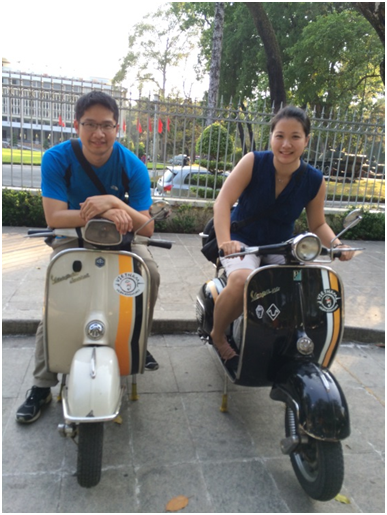
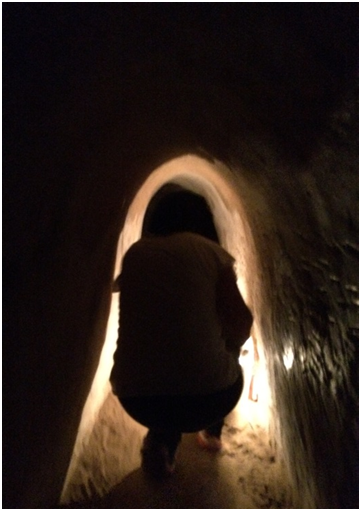
It’s very trouble-free to find out any topic on web as
compared to books, as I found this article at this website.
Hmm is anyone else experiencing problems with the images on this blog loading?
I’m trying to find out if its a problem on my ennd or if it’s thee blog.
Any responses would be greatly appreciated.
Write more, thats all I have to say. Literally,
it seems as though you relied on the video to make your point.
You obviously know what youre talking about,
why throw away your intelligence on just posting videos to
your blog when you could be giving us something informative to read?
With havin so much content do you ever run into any issues of plagorism or copyright infringement?
My site has a lot of unique content I’ve either written myself or outsourced but it looks like
a lot of it is popping it up all over the internet without my agreement.
Do you know any solutions to help prevent content from being stolen? I’d genuinely appreciate it.
I’m not that much of a internet reader to be honest but your sites really nice,
keep it up! I’ll go ahead and bookmark your site to come back down the road.
All the best